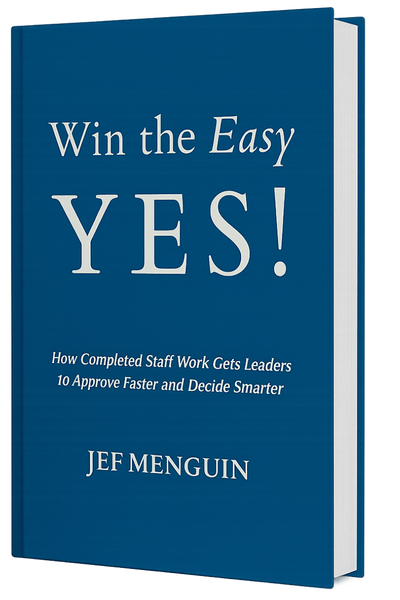You walk into the office. It’s Monday. Your boss drops a file on your desk.
“Figure out why sales are down,” they say. No instructions. No clues.
It’s on you to get to the bottom of it. What do you do?
Most people panic. They rush to throw together some half-baked ideas. Maybe slap a few charts on a PowerPoint and hope for the best.
But not you. Not this time.
You’re putting on your Sherlock Holmes hat. You’re about to dig deeper than anyone else would.
When I say research, I don’t mean skimming a couple of articles or glancing at last quarter’s reports. I mean real research. The kind Sherlock would do before solving a case.
Research: Why It’s the Key to Completed Staff Work
Completed Staff Work (CSW) is all about making decisions easy for your boss. You gather the data, analyze it, and hand over a solution so perfect, your boss doesn’t need to ask a single question. You’ve done all the thinking for them. Everything.
But the only way to get there is through solid, Sherlock-level research. Without that, you’re just guessing.
Imagine Sherlock stepping into a crime scene and not looking for clues. No fingerprints. No footprints. No dust. He’d be lost. And so would you if you skip the hard work of digging into the problem.
Here’s what happens when you don’t:
A quick report. A few bullet points. It comes back with questions, red ink, and frustration. You’re back to square one. Wasted time.
But when you do it right? You’re unstoppable. The case is cracked, and the problem is solved before your boss even lifts a finger.
The Sherlock Holmes Method: How to Research in CSW
Let’s walk through how you can research like Sherlock.
First thing’s first:
1. Collect the Clues
Sherlock doesn’t solve crimes by sitting in his office. He goes out. He collects clues. He talks to people. He examines every detail.
In CSW, this means gathering all the right information. You’re looking for primary data—customer feedback, employee interviews, firsthand observations. And secondary data—reports, market trends, competitor analysis.
But here’s the trick: don’t get lost in information overload. Not every detail matters. Sherlock doesn’t study every thread on the carpet. He looks at what points to the solution.
2. Look for Patterns
Sherlock was a master of finding connections where no one else could. A cigar butt by the fireplace. A footprint in the garden. Alone, they mean nothing. Together, they solve the case.
Your job is to connect the dots. Look at the data. Find the why. Are sales dropping because of a shift in customer behavior? Is there a competitor launching something new? What’s really going on beneath the surface?
Here’s a quick story.
In the early 2000s, GE noticed their refrigerator sales were dropping. The easy answer would have been to blame the market or slow demand. But their research team looked deeper. They dug into customer data. What they found changed everything: people wanted energy-efficient appliances.
The result? They launched the GE Profile Arctica refrigerator—one of the first energy-efficient models on the market. Sales skyrocketed. All because they connected the right dots.
3. Ask the Right Questions
Sherlock interrogates everyone. The maid. The suspect. The random guy in the street. He leaves no stone unturned.
You should do the same. Ask questions.
Talk to the sales team. What are they hearing from customers? Speak to the marketing department. Are they pushing the right message? What about customer service? Are complaints piling up?
In CSW, you’re not just collecting data—you’re asking. You’re diving deep into the problem.
4. Preempt the Boss’s Questions
Ever notice how Sherlock solves the case before anyone even realizes what happened? He anticipates every twist, every turn.
In CSW, you need to think ahead. When you present your research, imagine the questions your boss will ask—and answer them before they do.
- What are the risks?
- What if your recommendation fails?
- How much will it cost?
Cover all your bases. The more answers you have, the fewer questions your boss will need to ask. And the more impressed they’ll be with your work.
The GE Story: When Research Changes Everything
Let’s take a real-world example.
Back in the 1980s, General Electric was facing a tough decision. Their product line was underperforming. They needed answers, fast. A team was tasked with researching the problem and delivering a solution.
The first attempt? A generic report. Sales are down, maybe the market is slow, maybe it’s time to cut costs. But it lacked depth. It lacked research. Jack Welch, the legendary CEO, sent it back.
“Not good enough,” he said.
So the team went deeper. They did their homework. They interviewed customers, crunched data, and studied competitors. What they found was a growing demand for energy-efficient products. Something no one had noticed before.
Their solution? The GE Profile Arctica refrigerator—one of the first models to focus on energy savings. The result? A 40% jump in sales. That’s what happens when you research like Sherlock.
Common Pitfalls: Don’t Fall into the Trap
Even Sherlock makes mistakes. But here’s how you can avoid the common traps in research:
- Too much data: Don’t collect everything. Collect what matters.
- Confirmation bias: Don’t just look for data that backs up what you already think. Look for data that challenges it.
- Surface-level research: Don’t skim. Dig deeper. Always ask: why?
Put On Your Sherlock Holmes Hat
In Completed Staff Work, your job isn’t just to hand over information. It’s to solve the problem before your boss even knows it exists. And the key to solving it? Research. Sherlock-level research.
Next time you’re tasked with figuring something out, put on your Sherlock Holmes hat. Gather the right clues. Connect the dots. Ask the tough questions. And when you hand in your report, your boss will have nothing left to ask.
Because you’ve solved it.
Just like Sherlock would.
